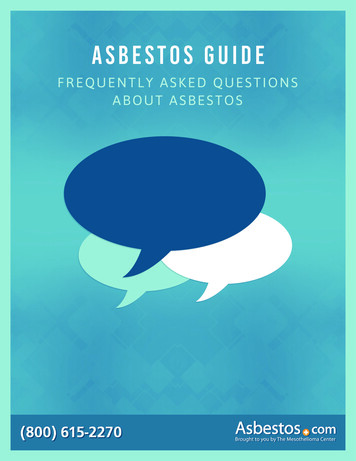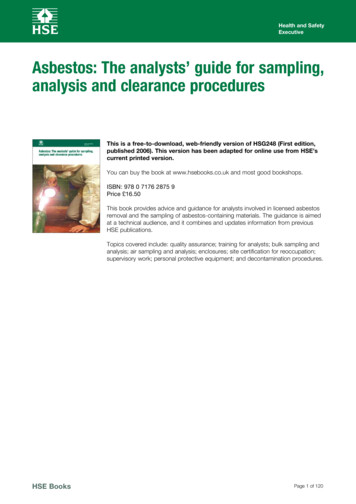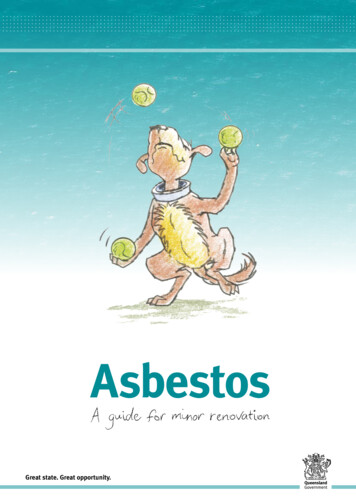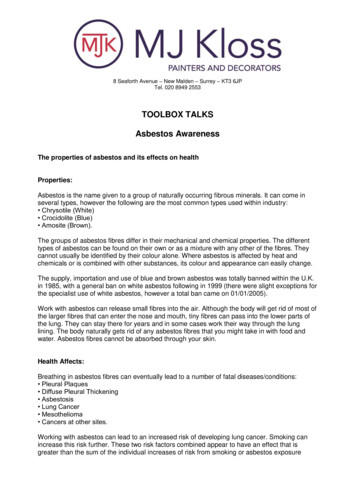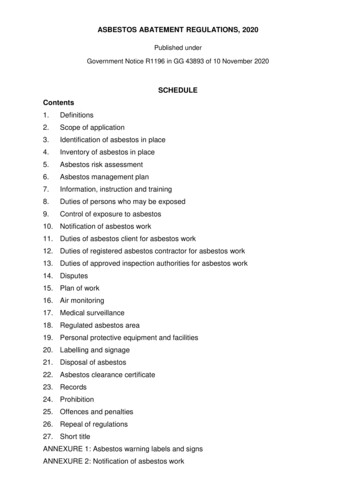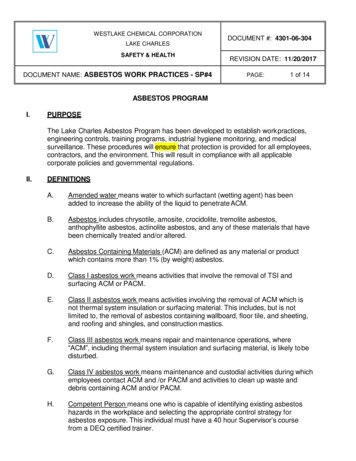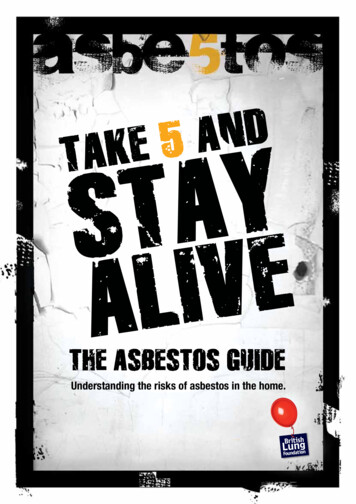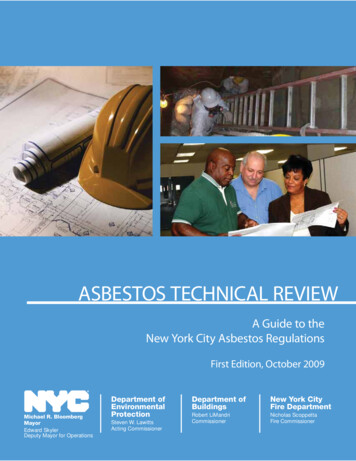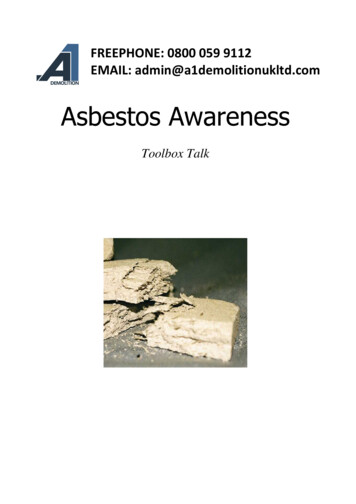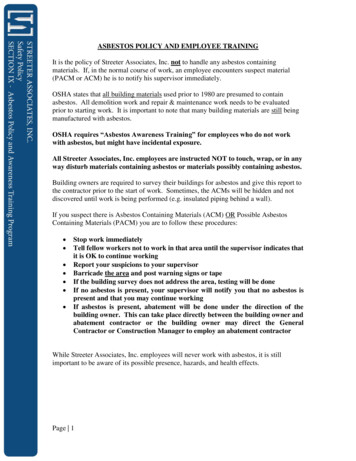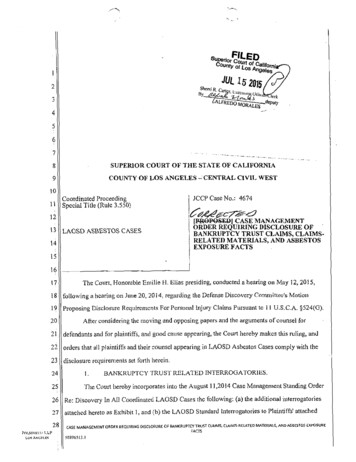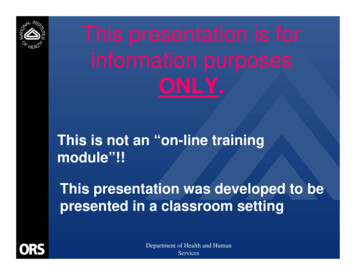
Transcription
This presentation is forinformation purposesONLY.This is not an “on-line trainingmodule”!!This presentation was developed to bepresented in a classroom settingDepartment of Health and HumanServices
AsbestosAwarenessTrainingPresented by:Gino K. Begluitti, MPH, CHMMLT, U.S. Public Health ServiceDivision of Occupational Health and SafetyTechnical Assistance BranchDepartment of Health and HumanServices
Asbestos Awareness Training covers: Regulation information on asbestosBackground information on asbestosLocation of ACM in the buildingsHealth effects of asbestosWorker protection programsRecognition of ACM damage anddeteriorationThe O&M program for buildingsProper response to fiber releaseDepartment of Health and HumanServices
Why are we doing this? Asbestos is: Potentially hazardous to healthSeems like its everywhereUnpredictableLaws and RegulationsDepartment of Health and HumanServices
Asbestos AwarenessThis module was prepared with informationprovided by: Agency for Toxic Substances and DiseaseRegistry (ATSDR)Occupational Safety and Health Administration(OSHA)Environmental Protection Agency (EPA)Department of Health and HumanServices
Asbestos Awareness - Definitions Asbestos: chrysotile, amosite, crocidolite, tremolite,anthophyllite, actinolite, and any of these mineralsthat have been chemically altered; includes PACMACM: "asbestos-containing material," any materialcontaining 1% asbestosPACM: "presumed asbestos-containing material"Surfacing Material: material that is sprayed, troweledon, or otherwise applied to surfacesThermal System Insulation (TSI): ACM applied topipes, fittings, boilers, breeching, tanks, ducts orother structural components to prevent heat loss orgainDepartment of Health and HumanServices
Who regulates asbestos? Environmental Protection Agency Occupational Health and SafetyAdministration National Emission Standards for Hazardous AirPollutants (NESHAPs)Asbestos Hazard Emergency Response Act(AHERA)Toxic Substances Control Act (TSCA)29 CFR 1910.1001 – General Industry Standard29 CFR 1926.1101 - Construction StandardState and Local AuthoritiesDepartment of Health and HumanServices
Who regulates asbestos? OSHA 29 CFR 1910.1001 The employer shall also provide, at no cost to employeeswho perform housekeeping operations in an area whichcontains ACM or PACM, an asbestos awareness trainingcourse, which shall at a minimum contain the followingelements: health effects of asbestos, locations of ACM andPACM in the building/facility, recognition of ACM and PACMdamage and deterioration, requirements in this standardrelating to housekeeping, and proper response to fiberrelease episodes, to all employees who performhousekeeping work in areas where ACM and/or PACM ispresent. Each such employee shall be so trained at leastonce a year.Department of Health and HumanServices
Who regulates asbestos? OSHA 29 CFR 1926.1101 Class I: Asbestos work activities involving removal of TSIand surfacing ACM and PACMClass II: Asbestos work activates involving the removal ofACM which is not TSI or surfacing material. This includes putis not limited to, the removal of asbestos wall board, floortile, sheet rock, shingles, and mastics.Class III: Asbestos work activates involving maintenanceand custodial where ACM including TSI is likely to bedisturbed.Class IV: Asbestos work activates involving maintenanceand custodial activities to clean up waste and debriscontaining ACM and PACM.Department of Health and HumanServices
EPA Bans on Asbestos NESHAP 1973 banned spray applied surfacing fireproofing /insulation1975 banned wet applied and pre-formed pipeinsulation1978 banned sprayed applied surfacingfireproofing for decorative purposesDepartment of Health and HumanServices
EPA Bans on Asbestos TSCA In 1989 EPA issue the “Asbestos Ban and PhaseOut Rule”The majority of the original ban was over ruled bythe U.S. Fifth Circuit Court of Appeals in 1991.Six materials were still banned: Corrugated paperRollboardCommercial paperSpecialty paperFloor feltNEW USES OF ASBESTOSDepartment of Health and HumanServices
EPA Bans on Asbestos TSCA – Material Not banned Asbestos-cement Corrugated Sheet, Asbestoscement Flat Sheet, Asbestos Clothing, PipelineWrap, Roofing felt, Vinyl-asbestos Floor Tile,Asbestos-cement Shingles, Clutch Facing,Frication Material, Disc Brake Pads, Drum BrakeLinings, Gaskets, Non-roof Coatings, RoofCoatings, Millboard, Asbestos Cement Pipe,Automatic Transmission Components, BrakeBlocksDepartment of Health and HumanServices
EPA Bans on AsbestosDepartment of Health and HumanServices
What is Asbestos?Department of Health and HumanServices
What is asbestos? The fire resistance properties of asbestoshave been known since ancient times.The Greeks used asbestos in lamp wicks.It is said that Charlemagne's tablecloth (whichaccording to legend, he threw in a fire toclean) was made of asbestos.Asbestos was used in fabrics such asEgyptian burial cloths.Department of Health and HumanServices
What Is Asbestos Asbestos is a naturally occurring mineralfiber.There are 6 types divided into 2 main groups.All asbestos groups are complex silicates.Asbestos is essentially inert.Department of Health and HumanServices
Asbestos Groups: The serpentine groupCharacterized by asbestos fibers which formcurly structures or appear coiled when viewedin their natural stateThere is only one type of asbestos under thegroup heading – ChrysotileChrysotile makes up 95% of the asbestosfound in building products.Department of Health and HumanServices
Chrysotile AsbestosDepartment of Health and HumanServices
Chrysotile AsbestosDepartment of Health and HumanServices
Asbestos Groups : The Amphibole group of asbestos ischaracterized by families of asbestos fiberswhich are thin and straightThis group includes the following: Amosite (brown asbestos)Crocidolite (blue t of Health and HumanServices
Chyrsotile vs. AmphiobleDepartment of Health and HumanServices
What is Asbestos?Asbestos fibers are identified byusing a microscopeAll types of asbestostend to break into verytiny fibers.These individual fibersare so small they mustbe identified using amicroscope.Some fibers may beup to 700 timessmaller than a humanhair.Department of Health and HumanServices
What is Asbestos?Because asbestosfibers are so small,once released into theair, they may staysuspended there forhours or even days.Department of Health and HumanServices
What is Asbestos? Asbestos fibers are virtually indestructible. They are resistant to chemicals and heat, and theyare very stable in the environment. They do not evaporate into air or dissolve in water,and they are not broken down over time. Asbestos is probably the best insulator known toman. Because asbestos has so many usefulproperties, it has been used in over 3,000 differentproducts.Department of Health and HumanServices
What is Asbestos? For OSHA and most other regulations amaterial must contain greater than 1%asbestos to be categorized as AsbestosContaining Material (ACM)In addition materials can be PresumedAsbestos Containing Materials (PACM)If a material is PACM it is subject to allregulations that apply to ACMDepartment of Health and HumanServices
Where is AsbestosFound?Department of Health and HumanServices
Where is Asbestos Found?Asbestos may be found in many different productsand many different places. Examples of products thatmight contain asbestos are: Sprayed-on fire proofing and insulation in buildingsInsulation for pipes and boilersWall and ceiling insulationCeiling tilesFloor tilesPutties, caulks, and cements (such as in chemical carryingcement pipes)Plaster materialMastic material (pipe, HVAC, sink)Department of Health and HumanServices
Where is Asbestos Found? Roofing shinglesSiding shingles on old residential buildingsWall and ceiling texture in older buildings and homesJoint compound in older buildings and homesBrake linings and clutch padsFire CurtainsLab Bench top SurfacesFire blanketsFire doorsGasketsRoof CoatingDepartment of Health and HumanServices
Where is Asbestos Found? The Usual Suspects: Sprayed-on insulation in locations such as variousmechanical rooms, steel reinforcing beams, andsome ceilings in older buildingsMost 9“ x 9” floor tiles in buildings built prior to1981Insulation around pipes and boilersInteriors of fire doorsDepartment of Health and HumanServices
Where is Asbestos? Building areas thathave asbestoscontaining materialsin them will havenotices posted nearthe entrances,frequently near thefire alarm panel.Department of Health and HumanServices
Where is Asbestos? Pipe and boilerinsulation thatcontains asbestoswill be labeled withidentifying stickersand placards.Department of Health and HumanServices
Where is Asbestos?Department of Health and HumanServices
Where is Asbestos?Department of Health and HumanServices
Where is Asbestos?Department of Health and HumanServices
Where is Asbestos?Department of Health and HumanServices
Where is Asbestos?Department of Health and HumanServices
Where is Asbestos?Department of Health and HumanServices
Where is Asbestos?Department of Health and HumanServices
Where is Asbestos?Department of Health and HumanServices
Where is Asbestos?Department of Health and HumanServices
Where is Asbestos?Department of Health and HumanServices
Where is Asbestos?Department of Health and HumanServices
Where is Asbestos?Department of Health and HumanServices
Where is Asbestos?Department of Health and HumanServices
Where is Asbestos?Department of Health and HumanServices
Where is Asbestos?Department of Health and HumanServices
Where is Asbestos?Department of Health and HumanServices
Where is Asbestos?Department of Health and HumanServices
Where is Asbestos?Department of Health and HumanServices
Where is Asbestos?Department of Health and HumanServices
Where is Asbestos?Department of Health and HumanServices
Where is Asbestos?Department of Health and HumanServices
Where is Asbestos?Department of Health and HumanServices
When is AsbestosDangerous?Department of Health and HumanServices
When is Asbestos Dangerous? The most common wayfor asbestos fibers toenter the body isthrough inhalation.Department of Health and HumanServices
When is Asbestos Dangerous? ACM is not generally considered to be harmfulunless it is releasing dust or fibers into the air wherethe fibers can be inhaled. Many of the fibers will become trapped in the mucousmembranes of the nose and throat where they canthen be removed, but some may pass deep into thelungs. Once they are trapped in the lungs, the fibers cancause health problems.Department of Health and HumanServices
When is Asbestos Dangerous? Asbestos is hazardous whenit is friable and is disturbed insuch a nature that it releasesfibers.The term "friable" means thatthe asbestos is easilycrumbled by hand, releasingfibers into the air.Asbestos floor tile is nonfriable.Asbestos ceiling tile is friableDepartment of Health and HumanServices
When is Asbestos Dangerous? Asbestos-containing ceiling tiles, floor tiles,undamaged laboratory cabinet tops,shingles, fire doors, siding shingles, etc. willnot release asbestos fibers unless theyare disturbed or damaged in some way. If an asbestos ceiling tile is drilled or broken,for example, it may release fibers into theair. If it is left alone and not disturbed, it willnot release fibers and doesn’t pose a healthrisk.Department of Health and HumanServices
When is Asbestos Dangerous? Asbestos pipe andboiler insulation doesnot present a hazardunless the protectivecanvas covering is cutor damaged in such away that the asbestosunderneath is exposedto the air.Department of Health and HumanServices
When is Asbestos Dangerous?Department of Health and HumanServices
When is Asbestos Dangerous?Department of Health and HumanServices
When is Asbestos Dangerous? Damage and deterioration will increase thelikelihood of disturbance of friable ACM, andcould result in a fiber release. Water damage, continual vibration, aging,and physical impact such as drilling,grinding, buffing, cutting, sawing, orstriking can break the materials downmaking fiber release more likely.Department of Health and HumanServices
Health EffectsDepartment of Health and HumanServices
Health Effects A Quick Review of theRespiratory SystemConsists of ever smallertubes TracheaPrimary bronchiSecondary bronchiTertiary BronchiGas exchange bronchiAlveoliDepartment of Health and HumanServices
Health Effects Because it is so hard to destroy asbestosfibers, the body cannot break them down orremove them once they are lodged in lungor body tissues. They remain in place wherethey can cause disease. There are three primary diseases associatedwith asbestos exposure: AsbestosisLung CancerMesotheliomaDepartment of Health and HumanServices
Asbestosis Asbestosis is a serious, chronic, noncancerous respiratory disease. Inhaledasbestos fibers aggravate lung tissues,which cause them to scar.Scar tissue is not able to transfer oxygentherefore as scaring increases lung functiondecreases.Symptoms of asbestosis include shortness ofbreath and a dry crackling sound in the lungswhile inhaling. In its advanced stages, thedisease may cause cardiac failure because itis so difficult to breath.Department of Health and HumanServices
Asbestosis There is no effective treatment for asbestosis; thedisease is usually disabling and can cause death.The risk of asbestosis is minimal for those who donot work with asbestos; the disease is rarely causedby neighborhood or family exposure.Typical latency period is approximately 15-30 yearsDepartment of Health and HumanServices
Asbestosis Smoking and Asbestos Smoking temporarily paralyzes the ciliated cells ofthe trachea and bronchiThese ciliated cells line the trachea and bronchiwalls and provide an escalator-like action.This is a mechanism designed to remove particlesfrom the lungs and deposit them into the digestivesystem where they are passed.As smokers paralyze these cells more particlescan be deposited into the deeper portions of thelung, increasing the risk of asbestosisDepartment of Health and HumanServices
Lung Cancer Lung cancer causes the largest number of deathsrelated to asbestos exposure.The incidence of lung cancer in people who aredirectly involved in the mining, milling,manufacturing and use of asbestos and its productsis much higher than in the general population.The most common symptoms of lung cancer arecoughing and a change in breathing. Othersymptoms include shortness of breath, persistentchest pains, hoarseness, and anemia.Department of Health and HumanServices
Lung Cancer People who have been exposed to asbestos andare also exposed to some other carcinogen -- suchas cigarette smoke -- have a significantly greaterrisk of developing lung cancer than people whohave only been exposed to asbestos. One study found that asbestos workers who smokeare about 90 times more likely to develop lungcancer than people who neither smoke nor havebeen exposed to asbestos. Smoking has a synergistic effect with asbestosexposureDepartment of Health and HumanServices
Mesothelioma Mesothelioma is a rare form of cancer that mostoften occurs in the thin membrane lining of thelungs, chest, abdomen, and (rarely) heart.About 200 cases are diagnosed each year in theUnited States.Virtually all cases of mesothelioma are linked withasbestos exposure.Approximately 2 percent of all miners and textileworkers who work with asbestos contractmesothelioma.Mesothelioma has an approximate latency period of30-40 years.Department of Health and HumanServices
Determining Factorsfor DiseaseDepartment of Health and HumanServices
Determining FactorsMain factors in determining your likelihood ofdeveloping asbestos related diseases are:1. The amount and duration of exposure - themore you are exposed to asbestos and the morefibers that enter your body, the more likely you areto develop asbestos related problems. While thereis no "safe level" of asbestos exposure, peoplewho are exposed more frequently over a longperiod of time are at higher risk.Department of Health and HumanServices
Determining Factors2. Whether or not you smoke - if you smoke andyou have been exposed to asbestos, you are farmore likely to develop lung cancer than someonewho does not smoke and who has not beenexposed to asbestos.If you work with asbestos or have been exposed toit, the first thing you should do to reduce yourchances of developing cancer is to stop smoking.Department of Health and HumanServices
Determining FactorsOrganizations that may offer programs,support, or information to help people stopsmoking are: National Cancer Institute (1-800-4-CANCER) American Heart Association (1-800-242-8721) American Lung Association (1-800-586-4872)Department of Health and HumanServices
How to AvoidAsbestos ExposureDepartment of Health and HumanServices
How to Avoid Exposure In order to avoid being exposed toasbestos, you must be aware of thelocations it is likely to be found. If you do not know whether something isasbestos or not and it fits the suspectmaterial category, assume that it is until itis verified otherwise. Remember that you cannot tell if floor orceiling tiles contain asbestos just by lookingDepartment of Health and Humanat them.Services
How to Avoid Exposure The Division of Occupational Health andSafety has a contractor that can takesamples from materials in order todetermine whether or not they containasbestos. If you would like to have materialsanalyzed or tested for asbestos, pleasecontact DOHS (301-496-3457).Never try to take a sample yourself unlessyou have been trained to do so.Department of Health and HumanServices
How to Avoid ExposureNever DrillHammerCutSawBreakDamageMoveDisturb.any asbestoscontaining materialsor suspectedmaterials. This couldrender the materialFriable.Department of Health and HumanServices
How to Avoid Exposure The NIH has surveyed all campus buildingsfor the presence of asbestos.The NIH also has an Operations andMaintenance (O&M) plan established.If you need to do work that might involveasbestos (replacing ceiling tiles, repairinginsulated pipelines, drilling into floor tilesetc.), check with DOHS to find out how thework can be done safely.Department of Health and HumanServices
How to Avoid Exposure For example, before drilling into any floortiles to perform maintenance work, it will benecessary to ensure they do not containasbestos. If they do contain asbestos, special workpractices will need to be taken to preventrendering the ACM friable during work.Department of Health and HumanServices
Housekeeping & Asbestos Housekeepers and custodiansshould never sand or dry buffasbestos containing floor tiles,and only wet stripping methodsshould be used during strippingoperations. If abrasion pads are requiredthey should be low abrasionpads, and should be used atspeeds below 300 RPM.Department of Health and HumanServices
Asbestos Spills It is important to report any damaged asbestoscontaining materials to DOHS and yoursupervisor immediately.If, for example, you discover some sprayed-onasbestos insulation has been knocked off of aceiling or wall, this would be considered a "spill."As such it would need to be cleaned up immediatelyby asbestos abatement workers.Do not attempt to clean up spillsyourself!Department of Health and HumanServices
Asbestos SpillsDepartment of Health and HumanServices
Avoiding ExposureBy knowing whereasbestos is likely to belocated and then takingmeasures not to disturbit, you will protectyourself and others fromexposure to thishazardous substance.Department of Health and HumanServices
Occupational Medical Services If at any time you feel that you have beenexposed to damaged or disturbed, friableACM, notify your supervisor, contact DOHSand visit OMS to document the exposure.OMS and DOHS will investigate the potentialexposure to determine if additional medicaland/or environmental monitoring is required.OMS is located atBuilding 106th Floor Room 6C306Department of Health and HumanServices
Important Contact Information Division of Occupational Health and Safety Ph. 301-496-3457Occupational Medical Services Ph. 301-496-4411Department of Health and HumanServices
Asbestos-cement Corrugated Sheet, Asbestos-cement Flat Sheet, Asbestos Clothing, Pipeline . Facing, Frication Material, Disc Brake Pads, Drum Brake Linings, Gaskets, Non-roof Coatings, Roof Coatings, Millboard, Asbestos Cement Pipe, Automatic Transmission Components, Brake Blocks . Department of Health and Human Services. Department of Health .
